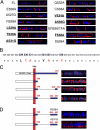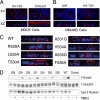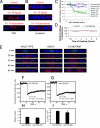A unique element in the cytoplasmic tail of the type II transforming growth factor-beta receptor controls basolateral delivery
- PMID: 17634290
- PMCID: PMC1995729
- DOI: 10.1091/mbc.e06-10-0930
A unique element in the cytoplasmic tail of the type II transforming growth factor-beta receptor controls basolateral delivery
Abstract
Transforming growth factor (TGF)-beta receptors stimulate diverse signaling processes that control a wide range of biological responses. In polarized epithelia, the TGFbeta type II receptor (T2R) is localized at the basolateral membranes. Sequential cytoplasmic truncations resulted in receptor missorting to apical surfaces, and they indicated an essential targeting element(s) near the receptor's C terminus. Point mutations in the full-length receptor confirmed this prediction, and a unique basolateral-targeting region was elucidated between residues 529 and 538 (LTAxxVAxxR) that was distinct, but colocalized within a clinically significant signaling domain essential for TGFbeta-dependent activation of the Smad2/3 cascade. Transfer of a terminal 84 amino-acid fragment, containing the LTAxxVAxxR element, to the apically sorted influenza hemagglutinin (HA) protein was dominant and directed basolateral HA expression. Although delivery to the basolateral surfaces was direct and independent of any detectable transient apical localization, fluorescence recovery after photobleaching demonstrated similar mobility for the wild-type receptor and a missorted mutant lacking the targeting motif. This latter finding excludes the possibility that the domain acts as a cell membrane retention signal, and it supports the hypothesis that T2R sorting occurs from an intracellular compartment.
Figures







Similar articles
-
Basolateral delivery of the type I transforming growth factor beta receptor is mediated by a dominant-acting cytoplasmic motif.Mol Biol Cell. 2017 Oct 1;28(20):2701-2711. doi: 10.1091/mbc.E17-05-0334. Epub 2017 Aug 2. Mol Biol Cell. 2017. PMID: 28768825 Free PMC article.
-
A kinase subdomain of transforming growth factor-beta (TGF-beta) type I receptor determines the TGF-beta intracellular signaling specificity.EMBO J. 1997 Jul 1;16(13):3912-23. doi: 10.1093/emboj/16.13.3912. EMBO J. 1997. PMID: 9233801 Free PMC article.
-
Vectorial TGFbeta signaling in polarized intestinal epithelial cells.J Cell Physiol. 2010 Aug;224(2):398-404. doi: 10.1002/jcp.22135. J Cell Physiol. 2010. PMID: 20432436
-
Identification of a basolateral sorting signal within the cytoplasmic domain of the interleukin-6 signal transducer gp130.Cell Signal. 2006 Aug;18(8):1140-6. doi: 10.1016/j.cellsig.2005.09.006. Epub 2005 Nov 7. Cell Signal. 2006. PMID: 16274960
-
Basolateral sorting of transforming growth factor-alpha precursor in polarized epithelial cells: characterization of cytoplasmic domain determinants.Exp Cell Res. 2003 May 1;285(2):159-74. doi: 10.1016/s0014-4827(03)00035-1. Exp Cell Res. 2003. PMID: 12706112
Cited by
-
Basolateral BMP signaling in polarized epithelial cells.PLoS One. 2013 May 13;8(5):e62659. doi: 10.1371/journal.pone.0062659. Print 2013. PLoS One. 2013. PMID: 23675417 Free PMC article.
-
Retromer maintains basolateral distribution of the type II TGF-β receptor via the recycling endosome.Mol Biol Cell. 2013 Jul;24(14):2285-98. doi: 10.1091/mbc.E13-02-0093. Epub 2013 May 29. Mol Biol Cell. 2013. PMID: 23720763 Free PMC article.
-
Strategies for exploring TGF-β signaling in Drosophila.Methods. 2014 Jun 15;68(1):183-93. doi: 10.1016/j.ymeth.2014.03.016. Epub 2014 Mar 27. Methods. 2014. PMID: 24680699 Free PMC article. Review.
-
Signaling Receptors for TGF-β Family Members.Cold Spring Harb Perspect Biol. 2016 Aug 1;8(8):a022053. doi: 10.1101/cshperspect.a022053. Cold Spring Harb Perspect Biol. 2016. PMID: 27481709 Free PMC article. Review.
-
Cell density sensing alters TGF-β signaling in a cell-type-specific manner, independent from Hippo pathway activation.Dev Cell. 2015 Mar 9;32(5):640-51. doi: 10.1016/j.devcel.2015.01.011. Dev Cell. 2015. PMID: 25758862 Free PMC article.
References
-
- Anders R. A., Dore J. J., Jr, Arline S. L., Garamszegi N., Leof E. B. Differential requirement for type I and type II transforming growth factor β receptor kinase activity in ligand-mediated receptor endocytosis. J. Biol. Chem. 1998;273:23118–23125. - PubMed
-
- Anders R. A., Leof E. B. Chimeric granulocyte/macrophage colony-stimulating factor/transforming growth factor-beta (TGF-β) receptors define a model system for investigating the role of homomeric and heteromeric receptors in TGF-β signaling. J. Biol. Chem. 1996;271:21758–21766. - PubMed
-
- Aroeti B., Okhrimenko H., Reich V., Orzech E. Polarized trafficking of plasma membrane proteins: emerging roles for coats, SNAREs, GTPases and their link to the cytoskeleton. Biochim. Biophys. Acta. 1998;1376:57–90. - PubMed
Publication types
MeSH terms
Substances
Grants and funding
LinkOut - more resources
Full Text Sources

